Regarding "the last fall of the elderly", these core messages must be told to parents!

|
The sudden death of Academician Yuan Longping, the father of hybrid rice in China, has caused the whole country to mourn, and has also made more people hear about the "last fall of the old man". In fact, falls are the number one cause of injury and death among people over 65 in my country, and 30-40% of the elderly have experienced falls. Especially for fractures of the hip, femoral head, and femoral neck, 50% of the elderly cannot survive for more than a year, so it is called the "last fracture". My father, who is over 70 years old, also fell on the ice and fractured his intertrochanteric femur at the end of last year. He was usually in good health and walked briskly, and he never thought that such a thing would happen to him. Fortunately, after surgery and nutritional support, as well as his own rehabilitation training with his iron will, he has basically recovered now, although he has suffered from pain for several months. At his age, this is the best result. We all have parents who need our care, and we will all grow old one day. Preventing and coping with falls in the elderly should become a compulsory course in life. I am not an expert in this area. I have summarized the following core information by combing through existing materials and combining my knowledge. It may not be comprehensive, but it can be used as a reference. Main causes of falls (Not necessarily comprehensive, the same below) 1. Muscle loss/sarcopenia, insufficient leg support (especially the quadriceps, the muscles on the front of the thigh), insufficient foot lift height, etc. (Note that "old people should eat less meat" is a very wrong concept) 2. Decreased coordination and balance of the limbs, and reduced flexibility of the joints and limbs 3. Slow reaction due to decreased vision, hearing, vestibular function and cognitive ability 4. Some mental states, diseases and drugs, such as depression, Parkinson's disease, hemiplegia, antidepressants, etc. 5. Environmental factors, such as insufficient light, obstacles in the walking path, etc. Common indoor scenarios for falls (About 50% of falls occur at home) 1. Toilet: standing up too quickly when using the toilet, slipping while bathing, and using the toilet at night 2. Kitchen, water stains and oil stains on the floor can cause slipping 3. Balcony, hang clothes while looking up and back 4. In the bedroom, lean back when taking items out of the upper wardrobe 5. Living room and bedroom, tripping over wires, carpets, floor mats, and slippers 6. Other indoor places: use stools or ladders to take or put items. Common outdoor scenarios for falls 1. Slipping on ice, flooded roads, or water-stained floors (tiles) 2. Uneven ground (up and down slopes or ridges or depressions) 3. Tripping over obstacles such as wires, ropes, isolation piers, manhole covers, etc. 4. Missing steps when going up or down stairs (including getting off a car) 5. Accidental collisions, such as collisions with children, pets, bicycles, and crowds, etc. 6. Falling due to heat stroke, hypoglycemia, high blood pressure, heart disease, etc. Key measures to prevent falls 1. Enhance prevention awareness and strengthen relevant knowledge learning 2. Keep exercising, do what you can, practice lower limb strength, balance, and stretch muscles and joints (Tai Chi is especially recommended, which can reduce the risk of falling by 50%) 3. Install handrails near the toilet, use stools and non-slip rubber mats in the shower. If possible, separate the dry and wet areas and keep the floor dry. 4. Wear non-slip shoes that fit your feet, and avoid wearing slippers, high heels, or shoes with too soft soles. 5. Place frequently used items in easy-to-access places. Do not climb high to get items. If necessary, use a dedicated ladder with handrails. 6. Reduce obstacles in aisles, do not use floor mats, and remove ground wires 7. The indoor lighting is bright. Turn on the light or use a flashlight when going to the toilet at night. 8. Make full use of handrails, crutches and walkers 9. Follow the doctor's instructions and use the medicine reasonably. Do not adjust the dosage at will. 10. Avoid turning your head quickly, turning around, squatting, or getting out of bed 11. Avoid carrying heavy objects 12. Drink less water before going to bed, avoid getting up frequently at night, and keep a urinal next to the bed 13. When getting on or off a vehicle, you must stop completely before proceeding. 14. Wearing glasses or hearing aids 15. Prevent osteoporosis 16. As the last line of defense, use your hands, elbows, and shoulders to cushion your fall and avoid your trunk, waist, and head from hitting the ground directly. Response to falls 1. Don’t rush to get up/help someone up, first assess the situation 2. If you are conscious and have no severe pain or suspected fractures, you can take a short rest, then slowly stand up/help yourself to make sure you are fine before moving further (it is best to have someone or something to help you). 3. If the patient is in severe pain, has obvious limb deformation, has crooked mouth and eyes, has weak hands and feet, has slurred speech, or has incontinence, do not move the patient to avoid further injury. Cover the patient with clothes to keep warm. 4. If there is bleeding from trauma, stop the bleeding. If there is vomiting, turn the head to the side and clean the mouth and nose to keep breathing unobstructed. 5. Stay calm and call 120 for help as soon as possible. If you need to move, lie flat and steady. 6. If you fall in a deserted place (including indoors), you can shout for help or make a phone call. If you cannot shout for help, find a hard object nearby to knock on the ground or pipes to make a sound to attract attention. Falling can easily lead to fractures, but it does not necessarily mean fractures. People with osteoporosis are more likely to have fractures. Osteoporosis risk factors and signs 1. Obesity 2. Alcoholism 3. Smoking 4. Insufficient or excessive protein intake 5. Sitting for a long time 6. Postmenopausal women 7. Excessive tea or coffee consumption 8. High-salt diet 9. Long-term use of certain drugs, such as glucocorticoids, due to illness 10. Old age 11. Some diseases, such as rheumatoid arthritis, diabetes, etc. 12. Low weight/emaciation 13. Low bone density in physical examination 14. Height loss, hunchback, back and joint pain, and previous fractures The peak of human bones generally occurs at the age of 30-35, after which they will gradually decline. This trend is almost irreversible, but it can be delayed as much as possible by changing dietary behavior. Key factors contributing to bone health 1. Adequate calcium intake, such as dairy products, tofu, calcium supplements, etc. 2. Exercise moderately, preferably with some strength training (the elderly also need it) 3. Get plenty of outdoor sunlight or take appropriate vitamin D supplements 4. Reduce or quit smoking and drinking 5. Keep tea and coffee drinking within a reasonable range (e.g. no more than 4 standard cups of coffee a day) 6. Eat a balanced diet, consume high-quality protein, and maintain a healthy weight 7. It would be more beneficial to do the above before reaching peak bone mass 8. Some menopausal women may need to use estrogen replacement therapy as prescribed by their doctor Fracture Care and Nutritional Support 1. Bedridden elderly people should pay special attention to preventing bedsores, thrombosis and lung infections 2. Eat a light diet, less oil, less salt, and less sweets 3. Eat a diversified diet and ensure adequate high-quality protein, such as lean meat, fish, shrimp, eggs, milk, tofu, etc. 4. Supplement VD and calcium appropriately (excessive calcium supplementation is not conducive to fracture recovery) 5. Drink plenty of water and avoid strong tea or coffee 6. Fruits and vegetables rich in dietary fiber (such as apples, oranges, kiwis, etc.) and whole grains, beans, and potatoes (such as oats, red beans, purple rice, sweet potatoes, etc.) can prevent constipation. 7. Bedridden elderly people should actively carry out muscle and joint activities under the guidance of doctors to prepare for rehabilitation and functional training after getting out of bed. Special note: The above content basically covers the key points in the prevention and treatment of falls in the elderly, but there are inevitably omissions and perhaps inaccurate descriptions, so it is for reference only. The former Ministry of Health issued the "Guidelines for Intervention of Falls in the Elderly" in 2011. The content is detailed and well-documented. Interested friends can search and download it for study. The United States, the United Kingdom, and Australia also have similar guidelines, but I did not look for them due to time and energy constraints. I hope everyone can live a safe and healthy life, and I also wish the elderly around the world can enjoy a peaceful and prosperous old age. |
Recommend
Precautions for pregnancy with rudimentary uterus
There are many congenital uterine diseases, such ...
Can I take a urine test during my period?
Urinalysis is a very common examination method in...
Treatment for uterine wall shedding
Everyone knows the importance of the uterus. The ...
When persimmon meets the intestinal tract
Many people have had this experience: after eatin...
Six months pregnant belly falling
If you are six and a half months pregnant and fee...
Red dates, longan and wolfberry stimulate menstruation
For female friends, menstruation is a very normal...
What are the ways for muscular girls to lose weight?
It is more difficult for muscular girls to lose w...
Can cervical cysts be cured by traditional Chinese medicine?
When female friends hear that they have cervical ...
Does leep affect fertility?
With the development of medical technology, many ...
Dragon fruit weight loss method, dragon fruit should be eaten like this
Dragon fruit is a nutritious fruit with low calor...
Middle-aged and elderly people should not ignore "incorrect vision", as this disease has a high rate of blindness!
We often say that "eyes are the windows to t...
Is Chinese medicine or Western medicine better for gynecology?
With the improvement of living standards, people&...
If my period doesn't come, will the anti-inflammatory injection come out?
In fact, many of my friends experience irregular ...
Pregnant woman's belly feels hard
During pregnancy, the physical condition of the p...









![[Medical Q&A] What are the rules and characteristics of normal children’s intellectual development?](/upload/images/67eff8b2a945b.webp)